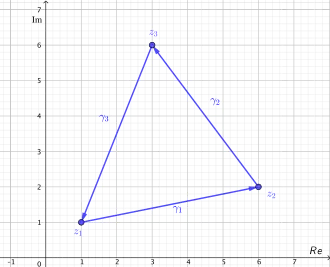Smooth paths and path subdivision
The following definitions were abbreviated with acronyms and are used as justifications for transformations or conclusions in proofs.
- (WG1) Definition (Smooth path): A path :[a,b]\to \mathbb {C} }
![{\displaystyle \gamma :[a,b]\to \mathbb {C} }](../4ba8e67ece48ed58462781818669d29170ae4809.svg) is smooth if it is continuously differentiable.
is smooth if it is continuously differentiable.
- (UT) Definition (Subdivision): Let
![{\displaystyle [a,b]}](../9c4b788fc5c637e26ee98b45f89a5c08c85f7935.svg) be an interval,
be an interval,  and
and  .
.  is called a subdivision of
is called a subdivision of ![{\displaystyle {\left[{a},{b}\right]}}](../218c5a550234daaeebb7fe581a9d9c5d8ccfe692.svg) .
.
- (WG2) Definition (Path subdivision): Let :[a,b]\to \mathbb {C} }
![{\displaystyle \gamma :[a,b]\to \mathbb {C} }](../4ba8e67ece48ed58462781818669d29170ae4809.svg) be a path in
be a path in  ,
,  ,
,  a subdivision of
a subdivision of ![{\displaystyle [a,b]}](../9c4b788fc5c637e26ee98b45f89a5c08c85f7935.svg) ,
, ![{\displaystyle \gamma _{k}:{\left[{u}_{{k}-{1}},{u}_{k}\right]}\to \mathbb {C} }](../e68d17150031bf3855b5789c04bb6eca3fd166c3.svg) for all
for all  a path in
a path in  .
.  is called a path subdivision of
is called a path subdivision of  if
if  and for all
and for all  and
and ![{\displaystyle {t}\in {\left[{u}_{{k}-{1}},{u}_{k}\right]}}](../65b609fcbc93b5afc68b7dbdedbbe0076acaf0a1.svg) we have
we have  .
.
- (WG3) Definition (Piecewise smooth path): A path :{\left[{a},{b}\right]}\to \mathbb {C} }
![{\displaystyle \gamma :{\left[{a},{b}\right]}\to \mathbb {C} }](../54fd4de339dd0c75918fcb2fa4ca67e88ce1bf7c.svg) is piecewise smooth if there exists a path subdivision
is piecewise smooth if there exists a path subdivision  of
of  consisting of smooth paths
consisting of smooth paths  for all
for all  .
.
Integration path
- (WG4) Definition (Path integral): Let
 be a continuous function and :[a,b]\to U}
be a continuous function and :[a,b]\to U}
![{\displaystyle \gamma :[a,b]\to U}](../d032547cae79cddd62ad7e267d9073b29a5a89d0.svg) a smooth path, then the path integral is defined as:
a smooth path, then the path integral is defined as:  . If
. If  is only piecewise smooth with respect to a path subdivision
is only piecewise smooth with respect to a path subdivision  , then we define
, then we define  .
.
- Definition (Integration path): An integration path is a piecewise smooth (piecewise continuously differentiable) path.
Example

The following path is piecewise continuously differentiable (smooth) and for the vertices  the closed triangle path :[0,3]\to \mathbb {C} }
the closed triangle path :[0,3]\to \mathbb {C} }
![{\displaystyle \gamma :[0,3]\to \mathbb {C} }](../f7ae39234b02b016151a7d879b74d236d7765bd0.svg) is not differentiable. The triangle path is defined on the interval
is not differentiable. The triangle path is defined on the interval ![{\displaystyle [0,3]}](../d5c9e70f7d437509d4ebedb0eaf7ada946e91a79.svg) as follows:
as follows:
![{\displaystyle \gamma (t):=\left\langle z_{1},z_{2},z_{3}\right\rangle (t):={\begin{cases}(1-t)\cdot z_{1}+t\cdot z_{2}&{\text{for }}t\in [0,1]\\(2-t)\cdot z_{2}+(t-1)\cdot z_{3}&{\text{for }}t\in (1,2]\\(3-t)\cdot z_{3}+(t-2)\cdot z_{1}&{\text{for }}t\in (2,3]\\\end{cases}}}](../eefa3ab713229c860bb4a6dcbd5087378df38157.svg)
Paths from convex combinations
The piecewise continuously differentiable path is formed from convex combination.The sub-paths
 with
with ![{\displaystyle \gamma _{1}:[0,1]\to \mathbb {C} ,\ (1-t)\cdot z_{1}+t\cdot z_{2}}](../d7a93d43a4f0592b505c774b9cf7cfe49cd8a483.svg)
 with
with ![{\displaystyle \gamma _{2}:[1,2]\to \mathbb {C} ,\ (2-t)\cdot z_{2}+(t-1)\cdot z_{3}}](../1315423bd28ff002e4c1ab6012f6513915440ac5.svg)
 with
with ![{\displaystyle \gamma _{3}:[2,3]\to \mathbb {C} ,\ (3-t)\cdot z_{3}+(t-2)\cdot z_{1}}](../b77d2d72edc1c1b9a960b9cc82be6e886e67d8bd.svg)
are continuously differentiable.

![]()